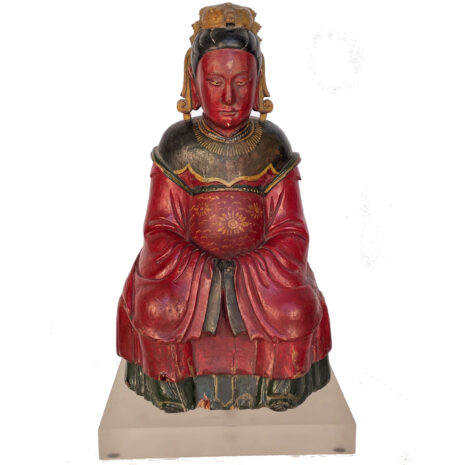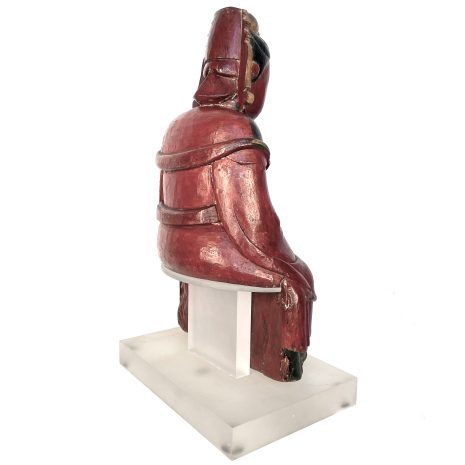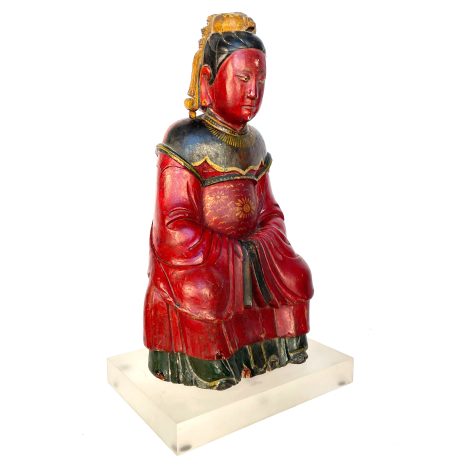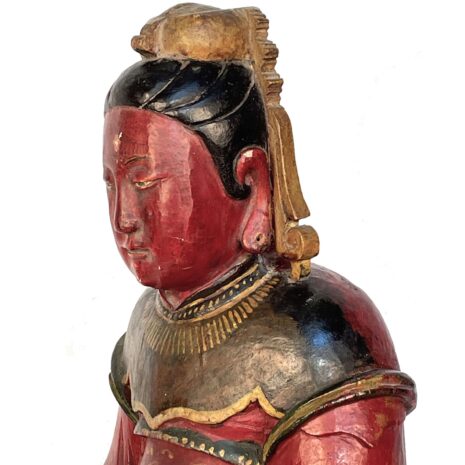Antique Heavenly Taoist Empress Mazu, China (5677)
Original price was: $1,750.00.$1,150.00Current price is: $1,150.00.
H: 21” W: 11.5” D: 8” | FOR SHIPPING call 213-568-3030 or email [email protected]
Temples for “Heavenly Empress” Mazu in southern China coastal regions protect sea faring peoples. This motherly home altar statue reflects that although childless, she protects her children – her devotees – as a mother. Seated on lucite base.
Description
Mazu (Matsu) is the Goddess of the Sea who protects seafaring populations and coastal populations and a tutelary deity venerated as the “Protector of the Sea.” A syncretic deity, she embraced by all Chinese peoples, in written traditions of the imperial Chinese hierarchy who officially deified her and built sanctioned monuments and temples to her since the Song Dynasty and in oral traditions by masses who follow her in Taoist, Buddhist, and Popular Religion traditions. Although Mazu is generally considered Taoist, Guanyin is believed to have been very devoted to Mazu and some believe she was incarnated as Mazu. After visiting a Guanyin temple as a child she became a devout Buddhist. Her association with the provincial Empress of Heaven tradition is strongest in southern China coastal regions, Hong Kong and Taiwan where community temples were built called Mazu Temples or Heavenly Empress Taoist Halls. In the provincial tradition like here, more humble and approachable Mazu images were and still are created for clan, temple or a home altar where she is portrayed as matronly and motherly, reflecting the belief that although she was childless, she protects her children – her devotees – as a mother would. In these regions she is affectionately called Ma Tsu P’o, which translates as “Mother”, “Granny” or “Grandmother,” and “Auntie Lin. Her hands are clasped at her waist concealed by her black lined sleeves, a common pose for Taoist-deities and her hair is pulled under the simple provincial iconic headdress shaped as a phoenix. Mazu is often dressed in red so travelers at sea can easily spot her if they need assistance. In Popular Religion belief, devotees never pray to her using her formal name since if she is called by one of her formal titles such as “Empress of Heaven,” she would feel compelled to dress formally which would delay her response. Identified by Irvin as one of the Great Chinese Goddesses she is a universal deity who epitomizes the feminine role of compassionate protectors and grants health, long life and safety to all devotees regardless of their class. Three ornamental flowers painted on her stomach might reflect the Popular Religion myth that when Mazu’s mother was pregnant, she prayed for a daughter as she already had six sons. In a dream Guanyin gave her a flower blossom to wear, and the next day Mazu was born.This piece is wonderfully carved and is in excellent condition with exception of a few lacquer losses. She originally sat on a detached throne that is now replaced by an acrylic base.
Sources:
Lee Irwin, “Divinity and Salvation: The Great Goddesses of China,” in Asian Folklore Studies, Indiana University, Vol. 49, 1990, pp 53-68.
Claudia Monique, “Matsu/Mazu Goddess of Sea,” May 20, 2014.
Additional information
| Period | Antique, Qing Dynasty |
|---|---|
| Date | Late 19th/Early 20th Century |
| Materials and Technique | Wood |
| Dimensions (inches) | Ht: 21” W: 11.5” D: 8” |
| Dimensions (metric) | Ht: 53.34cm W: 29.21cm D: 20.32cm |
| Weight | 14 lbs 7 oz |
| Condition | Excellent, age appropriate signs of wear |
| Item Number | 5677JACK |
| Shipping Box Size | Oversized. Call 213-568-3030 or email [email protected] for shipping. |










